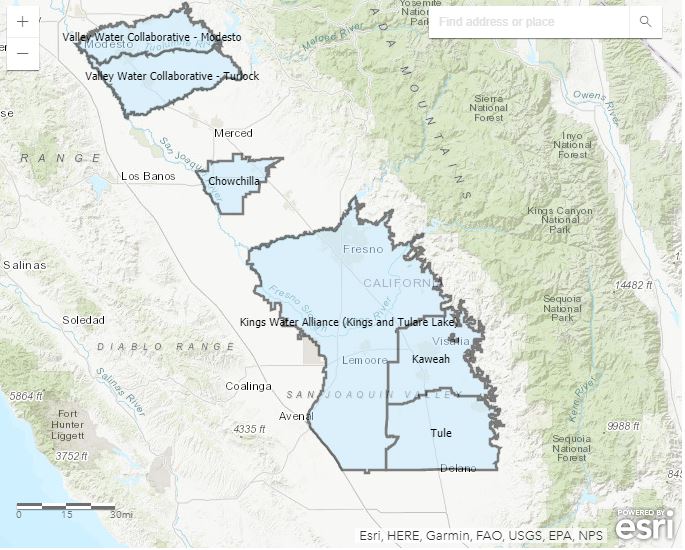Free water deliveries have started for some San Joaquin Valley residents with nitrate contaminated wells.
But advocates worry that nine months into the state’s nitrate control program, outreach has been lacking and not enough wells have been tested.
The nitrate control program launched in May of 2021. It offers free water deliveries for residents whose wells test over the limit for nitrates. The program is mandated by the State Water Resources Control Board and funded by nitrate polluters throughout the valley.
Nitrates can be harmful to pregnant women and infants and have infiltrated drinking water supplies in the valley from farming fertilizers, septic tanks, dairies and other wastewater sources.
The program includes five management zones that cover a large portion of the southern San Joaquin Valley from Fresno County to the northern part of Kern County, a chunk in the mid-valley around Chowchilla and another large section further north covering the Modesto and Turlock areas.
As of January 31, 678 wells have been tested in all of those areas. On average, about 65% of tested wells have been over the maximum contaminant level for nitrates. There are 455 households receiving bottled water deliveries through the program.
Those numbers are too low, according to Bryan Osorio, community solutions advocate at the nonprofit Community Water Center.
“That for us is a red flag,” said Osorio. “They’ve had since May of last year to do the outreach and it just hasn’t translated.”
Osorio said more in-person outreach needs to be done. Community Water Center staff have found that many residents have either never heard of the program or are still confused about how to start the process, said Osorio.
Data on domestic wells is lacking and nobody knows how many wells there are in the valley. A report commissioned by Community Water Center with other nonprofits estimates there are about 33,000 domestic wells throughout the valley, of which more than 5,000 are at the highest risk of nitrate contamination.
But without official data it’s hard to know exactly where private wells are and if they’re in a high risk area.
The state Water Board has created an aquifer risk map that shows where wells may be at risk. The map was created for the state’s drinking needs assessment to give staff a better idea of where to prioritize drinking water resources. The map was created by using any available localized data to estimate what contamination could be present in certain areas. But it’s still just an estimate.
“It’s hard because we have no data,” said Kristyn Abhold, senior environmental scientist for the state Water Board’s Needs Analysis Unit. “We can’t even tell you a percentage of wells that we think would have treatment for domestic wells in particular.”
In early 2022, the state Water Board launched an online database for state small water systems and domestic well data. But Abhold doesn’t expect to see a tidal wave of data any time soon.
“Until we see more pressure at the county level to require domestic well water quality samples, like on the resale of a home, I don’t think we’re going to see a whole lot of data here.”
That’s partly why outreach in rural areas is so difficult.
Angelica Garcia’s well has been contaminated with nitrates for decades. Garcia lives outside of Reedley in Fresno County with her husband and three children. They’ve lived in the home for 22 years. When they moved in they were going through the adoption process and were required to test their well which is how she found out it was contaminated by nitrates.
Garcia’s family bought bottled water to drink most of the time but they still used the contaminated water for cooking and washing and occasionally for drinking.
“I’m ashamed to admit that we didn’t really take any steps to correct it,” said Garcia.
So when Garcia received a flier in the mail last summer about the free nitrate control program, she didn’t hesitate to call.
The process was easy after that, Garcia said. Within days, the Kings Water Alliance management zone sent someone to test their well which was contaminated with nitrates, as Garcia expected. A few days later, free bottled water delivery started. Garcia and her family receive 25 gallons of water every two weeks through the program.
“It’s a big relief because I feel a little bit guilty that I didn’t do more research on it before,” said Garcia. “I’ve had my kids drinking that water and cooking with that water too forever.”
Outreach is a problem, said Garcia. People often ignore notifications in the mail because they assume it’s an advertisement trying to sell something, she said. In the rural parts of the valley, there have often been companies that try to test wells in order to sell expensive water systems, she added.
“We’re doing our best to get the word out there that this is available,” said Charlotte Gallock, executive director the Kings Water Alliance. “We’re still fairly new, we’re working on it.”
Mailing fliers was the initial outreach push at the start of the program, said Gallock. But staff have also done more direct outreach at a food bank and an in-person workshop.
“We’re constantly changing it,” said Gallock. “We’re trying new methods regularly.”
Share this:
- Click to share on Facebook (Opens in new window)
- Click to share on Twitter (Opens in new window)
- Click to share on LinkedIn (Opens in new window)
- Click to share on Reddit (Opens in new window)
- Click to share on Tumblr (Opens in new window)
- Click to share on Pinterest (Opens in new window)
- Click to share on Pocket (Opens in new window)
- Click to share on Telegram (Opens in new window)
- Click to share on WhatsApp (Opens in new window)
- Click to print (Opens in new window)








